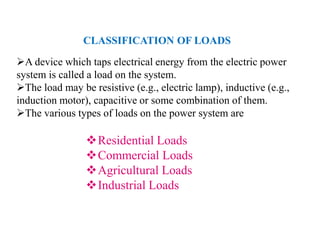EDS1.ppt
- 2. ELECTRICAL DISTRIBUTION SYSTEM • Classification of loads • Load modeling and characteristics • Distribution Feeders • Substations • Voltage droop and power-loss calculations • Protective Devices • Voltage Control & P.F Improvement
- 3. CLASSIFICATION OF LOADS Residential Loads Commercial Loads Agricultural Loads Industrial Loads A device which taps electrical energy from the electric power system is called a load on the system. The load may be resistive (e.g., electric lamp), inductive (e.g., induction motor), capacitive or some combination of them. The various types of loads on the power system are
- 4. Residential Loads/ Domestic Loads Residential Loads or Domestic load consists of lights, fans, refrigerators, heaters, television, small motors for pumping water etc. Most of the residential load occurs only for some hours during the day (i.e., 24 hours) e.g., lighting load occurs during night time and domestic appliance load occurs for only a few hours. For this reason, the load factor is low (10% to 12%).
- 5. Commercial Loads Commercial load consists of lighting for shops, fans and electric appliances used in restaurants etc. This class of load occurs for more hours during the day as compared to the domestic load. The commercial load has seasonal variations due to the extensive use of airconditioners and space heaters.
- 6. Agricultural Loads/ Irrigation Loads This type of load is the electric power needed for pumps driven by motors to supply water to fields. Generally this type of load is supplied for 12 hours.
- 7. Industrial Loads Industrial load consists of load demand by industries. The magnitude of industrial load depends upon the type of industry. Thus small scale industry requires load upto 25 kW, medium scale industry between 25kW and 100 kW and large-scale industry requires load above 500 kW. Industrial loads are generally not weather dependent.
- 8. Municipal load: Municipal load consists of street lighting, power required for water supply and drainage purposes. Street lighting load is practically constant throughout the hours of the night. For water supply, water is pumped to overhead tanks by pumps driven by electric motors. Pumping is carried out during the off-peak period, usually occurring during the night. This helps to improve the load factor of the power system. Traction load: This type of load includes tram cars, railways etc. This class of load has wide variation. During the morning hour, it reaches peak value because people have to go to their work place. After morning hours, the load starts decreasing and again rises during evening since the people start coming to their homes.
- 9. ELECTRICAL DISTRIBUTION SYSTEM • Classification of loads • Load modeling and characteristics • Distribution Feeders • Substations • Voltage droop and power-loss calculations • Protective Devices • Voltage Control & P.F Improvement
- 10. Distribution System Planning System planning is essential to assure that the growing demand for electricity can be satisfied by distribution system additions that are both technically adequate and reasonably economical. Factors Affecting System Planning Load Forecasting
- 13. Other Factors
- 14. LOAD CHARACTERISTICS Demand: “The demand of an installation or system is the load at the receiving terminals averaged over a specified interval of time”. Demand interval: It is the period over which the load is averaged. This selected Δt period may be 15 min, 30 min, 1 h, or even longer. Of course, there may be situations where the 15 and 30 min demands are identical. Maximum demand: “The maximum demand of an installation or system is the greatest of all demands which have occurred during the specified period of time”.
- 15. Utilization Factor: Plant Factor: Diversity factor: Demand Factor:
- 16. Coincidence factor: Contribution factor: Manning defines ci as “the contribution factor of the ith load to the group maximum demand.” It is given in per unit of the individual maximum demand of the ith load. Therefore, That is, the coincidence factor is equal to the contribution factor.
- 17. Load factor: Loss factor: Note: is applicable for the copper losses of the system but not for the iron losses.
- 18. An arbitrary and ideal load curve. RELATIONSHIP BETWEEN THE LOAD AND LOSS FACTORS
- 20. Case 1: Off-peak load is zero. Since p1=0 That is, the load factor is equal to the loss factor, and they are equal to the t/T constant. Case 2: Very short-lasting peak. Here, t=0 then That is, the value of the loss factor approaches the value of the load factor squared. Case 3: Load is steady. Here, t=T then That is, the value of the loss factor approaches the value of the load factor. Therefore, in general, the value of the loss factor is
- 21. However, Buller and Woodrow developed an approximate formula to relate the loss factor to the load factor as Loss factor curves as a function of load factor. (From Westinghouse Electric Corporation, Electric Utility Engineering Reference Book-Distribution Systems, Vol. 3, Westinghouse Electric Corporation, East Pittsburgh, PA, 1965.)
Editor's Notes
- #2: 1,2,4,5,,8,9, 213,5,26,29,33,34,35,37,38,41,42,43,44,l3,6,8,9,10,11,13,15




















